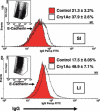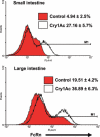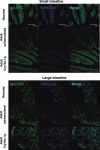Immunization with Cry1Ac from Bacillus thuringiensis increases intestinal IgG response and induces the expression of FcRn in the intestinal epithelium of adult mice
- PMID: 19906202
- PMCID: PMC7169514
- DOI: 10.1111/j.1365-3083.2009.02332.x
Immunization with Cry1Ac from Bacillus thuringiensis increases intestinal IgG response and induces the expression of FcRn in the intestinal epithelium of adult mice
Abstract
We have shown that Cry1Ac protoxin from Bacillus thuringiensis is a potent mucosal and systemic immunogen with adjuvant properties. Interestingly, we have observed that Cry1Ac preferentially induces high specific IgG responses in intestinal fluid when it is intraperitoneally administered to mice; therefore, in the present study, we used this protocol, as a model to address the influence of systemic immunization on the induction of the intestinal IgG response. The data shown indicate that upon intraperitoneal immunization with Cry1Ac, significant intestinal specific IgG cell responses were produced in the lamina propria, accompanied by an increased frequency of intestinal IgG+ lymphocytes and epithelial cells containing IgG. Considering that FcRn is the receptor responsible for the transport of IgG in neonatal intestinal epithelia, but it is developmentally downregulated in the rodent intestine, we analysed whether upon intestinal IgG induction, FcRn mRNA expression was induced in intestinal epithelial cells, of adult mice. Whereas in intestinal epithelia of unimmunized adult mice FcRn mRNA was not detected, in Cry1Ac immunized mice it was expressed, although the level was lower in comparison with that found in neonatal epithelia. Then using flow cytometry and immunofluorescence we confirmed that the expression of the protein FcRn was induced in the intestines of adult immunized mice especially in the large intestine. Finally, we found that Cry1Ac also increased FcRn expression in isolated intestinal epithelial cells stimulated in vitro. The outcomes suggest that the expression of FcRn in intestinal epithelium might be reactivated upon immunization, and possibly facilitate IgG transport.
Figures









Similar articles
-
Intraperitoneal Immunization with Cry1Ac Protoxin from Bacillus thuringiensis Provokes Upregulation of Fc-Gamma-II/and Fc-Gamma-III Receptors Associated with IgG in the Intestinal Epithelium of Mice.Scand J Immunol. 2015 Jul;82(1):35-47. doi: 10.1111/sji.12305. Scand J Immunol. 2015. PMID: 25904149
-
Intragastric and intraperitoneal administration of Cry1Ac protoxin from Bacillus thuringiensis induces systemic and mucosal antibody responses in mice.Life Sci. 1999;64(21):1897-912. doi: 10.1016/s0024-3205(99)00136-8. Life Sci. 1999. PMID: 10353588
-
Characterization of the mucosal and systemic immune response induced by Cry1Ac protein from Bacillus thuringiensis HD 73 in mice.Braz J Med Biol Res. 2000 Feb;33(2):147-55. doi: 10.1590/s0100-879x2000000200002. Braz J Med Biol Res. 2000. PMID: 10657055
-
The neonatal Fc receptor in mucosal immune regulation.Scand J Immunol. 2021 Feb;93(2):e13017. doi: 10.1111/sji.13017. Epub 2021 Jan 17. Scand J Immunol. 2021. PMID: 33351196 Review.
-
Neonatal Fc receptor (FcRn): a novel target for therapeutic antibodies and antibody engineering.J Drug Target. 2014 May;22(4):269-78. doi: 10.3109/1061186X.2013.875030. Epub 2014 Jan 9. J Drug Target. 2014. PMID: 24404896 Review.
Cited by
-
Vaccine-induced intestinal immunity to ricin toxin in the absence of secretory IgA.Vaccine. 2011 Jan 17;29(4):681-9. doi: 10.1016/j.vaccine.2010.11.030. Epub 2010 Nov 27. Vaccine. 2011. PMID: 21115050 Free PMC article.
-
No adjuvant effect of Bacillus thuringiensis-maize on allergic responses in mice.PLoS One. 2014 Aug 1;9(8):e103979. doi: 10.1371/journal.pone.0103979. eCollection 2014. PLoS One. 2014. PMID: 25084284 Free PMC article.
-
Neonatal Fc receptor: from immunity to therapeutics.J Clin Immunol. 2010 Nov;30(6):777-89. doi: 10.1007/s10875-010-9468-4. Epub 2010 Oct 1. J Clin Immunol. 2010. PMID: 20886282 Free PMC article. Review.
References
-
- Woof JM, Mestecky J. Mucosal immunoglobulins. Immunol Rev 2005;206:64–82. - PubMed
-
- Woof JM, Kerr MA. The function of immunoglobulin A in immunity. J Pathol 2006;208:270–82. - PubMed
-
- Robert‐Guroff M. IgG surfaces as an important component in mucosal protection. Nat Med 2000;6:129–30. - PubMed
-
- Baba TW, Liska V, Hofmann‐Lehmann R et al. Human neutralizing monoclonal antibodies of the IgG1 subtype protect against mucosal simian‐human immunodeficiency virus infection. Nat Med 2000;6:200–6. - PubMed
-
- Mbawuike IN, Pacheco S, Acuna CL, Switzer KC, Zhang Y, Harriman GR. Mucosal immunity to influenza without IgA: an IgA knockout mouse model. J Immunol 1999;162:2530–7. - PubMed
Publication types
MeSH terms
Substances
LinkOut - more resources
Full Text Sources

